 |
||||||||||||
| Hampton Court Orientals | ||||||||||||
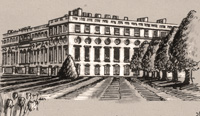 Hampton Court 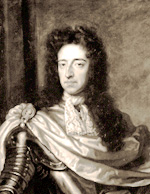 King William III (1650-1702)  Queen Anne (1665-1714) 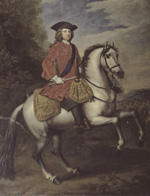 King George I (1660-1727) 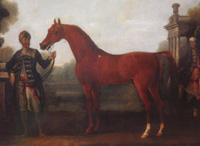 Hampton Court Arabian 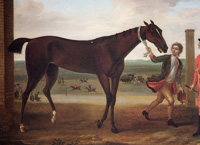 Courtesy of Richard Green Gallery Lord Halifax's Bumper |
Hampton Court, the
favourite residence of King Henry VIII, was briefly
occupied Oliver Cromwell and then languished somewhat until
King William and Queen Mary began the restoration of the
palace in 1689 and the refurbishment of the royal
paddocks in 1699 [History of Newmarket 3:361]. Bushy
(or Bushey) Park was probably also used for bloodstock
breeding by the Earls of Halifax. Charles Montague
(1661-1715), 1st Earl of Halifax, commenced the repair
of Bushy House in 1708 which was continued by his nephew
George Montague Dunk, the 1st Earl of Halifax (second
creation), who died in 1739. The latter is the breeder
of record of a number of offspring that were sired by
stallions either owned by King George I or who appeared to reside at Hampton
Court. Bloodstock breeding continued there until Queen
Victoria's final bloodstock sale in 1894. Since King William III (1650-1702) sent his stud master Richard Marshall to acquire horses from Barbary in 1699 Hampton Court has been home to a great many Arabians, Barbs, Turks and Persians. The identity of the nine stallions and five mares who were imported at that time is not definitively known although King William's White Barb Chillaby, his Black Barb without-a-tongue, John Hutton's Grey Barb and the Hampton Court Brown Barb are thought to be among them. Some of these doubtlessly remained at Hampton Court during the reign of Queen Anne (1702-14) and possibly as late as the reign of King George I (1714-1727). Richard Marshall (1659-1728) served as stud master to all three monarchs. |
|||||||||||
| Chillaby | ||||||||||||
| Chillaby [King William's White Barb] gr c 1695c. Sire Line Chillaby. One of a great many stallions who covered at Hampton Court, he sired five stud book offspring. Of these, two were stallions. Greyhound (gr c 1700c) a son of the "Natural Barb Mare" Slugey and imported in utero was the most influential as he left a large number of offspring, many of whom were instrumental in the establishment of the racehorse. Chillaby's other son, the Hampton Court Cripple Barb (b c 1705c), was less so although his daughter Lusty Thornton (ch f 1710c) was among the foundation mares of Family 2. The first of his daughters, Sister to Cripple Barb (f 1704c) was the grandam of the York Royal Plate winner Merryman (b g 174), the Hambleton Royal Plate winner, Mr Witty's Conyers Arabian Mare (gr f 1716 Conyers Arabian), and her brother Conyers Arabian Colt (c 1720c) who got the stallion Hodges Centurion (c 1725c). The next of his daughters, Halifax's Farmer Mare (f 1705c) was probably the most influential as most of Family 27 traces to her. His third daughter, Chillaby Mare (f 1706c), was the dam of the stallion Gallant's Smiling Tom (gr c 1710c Conyers Arabian). There is some circumstantial evidence that Chillaby was also the horse known as Honeywood's Arabian. Greyhound (GB) [Marshall's] gr c 1700c (King William's Chillaby Barb - Slugey). Sire Line Chillaby. Family 101. Greyhound, a "natural barb," was foaled at Hampton Court. Later purchased by William Crofts of Barforth he was a "common stallion" in Yorkshire although he covered some well bred mares. He sired nearly seventy known offspring including several good racehorses. His best runners were probably Lord Halifax's Goliah (gr c 1722) who won a 200 guineas match at Newmarket, the Gold Cup at Winchester and the King's Plate at Lewes and Lord Halifax's Sampson (gr c 1721) who won a 200 guineas match at Newmarket and King's Plates at Guildford, Lewes, Newmarket (twice) and Lincoln. His most significant sons were likely the two Young Greyhounds. Young Greyhound (gr c 1718) was said to have gotten few mares although he should probably be credited with some offspring usually assigned to the other Young Greyhound (br c 1723) sire of Miss Makeless (b f 1737) the ancestress of most of Family 2. Greyhound also sired several influential daughters including Sister to Guy (f 1722), the ancestress of most of Family 4, Sister to Sampson (ch f 1723) the ancestress of most of Family 12 and Brocklesby (gr f 1721) the ancestress of most of Family 23. Cripple Barb (GB) [Hampton Court Cripple Barb, Crofts Bay Barb] b c 1705c (Chillaby - Moonah Barb Mare, by Hampton Court Brown Barb). Sire Line Chillaby. Family 21. Bred in the Hampton Court stud of Queen Anne he was later given to Mr Crofts. The General Stud Book notes that "he got some horses that could run a little, but was a bad stallion" [Intro, Part 4]. He sired eight known offspring. Neither of his two colts bred on. His daughters faired slightly better with Mr Elstob's Cripple Barb Mare (f 1710c) of Family 4 the dam of the good stallion Cartouch (c 1717c Bald Galloway) and her sister the dam of Hodge's Centurion (c 1725c Conyers Arabian Colt). Lusty Thornton (ch f 1710c) was a foundation mare of Family 2. |
||||||||||||
| Conyers Arabian | ||||||||||||
| [Richards Arabian, Stanyans Arabian]
gr c 1700c. He was probably owned
by Thomas Conyers (d 1728), MP for Durham from 1698 to 1701 and 1702
to 1706, as well as equerry to Prince George of Denmark from 1704 to
1706. Abraham Stanyan (1669c-1732) was ambassador to Constantinople
from 1717 to 1730. Conyers Arabian covered at Hampton Court in the
reign of King George I. He has
ten known offspring, the most famous of these probably Gallant's
Smiling Tom (gr c 1710c), a successful stallion in his own right.
Other notable offspring include (1) Grey Whiteneck (gr f 1715c) of
Family 9 the ancestress of
such horses as Aristotle* (br c 1755
Cullen Arabian) and
Pacolet (gr c 1763
Blank), (2) the dam of
Diana (br f 1740 Godolphin's
Whitefoot) and
Charming Molly (br f 1742 Godolphin Whitefoot)
between them ancestresses of much of
Family 13, (3) the dam of
Bridgewater's Star (c
1725 Ashridge Ball), (4) the grandam of
the winner Chedworth's Moses (ch c 1746 Howe's Foxhunter), (5) the
great grandam of the winner Aimwell (gr c 1750
Babraham) and (6) the Conyers
Arabian Colt, sire of Hodge's Centurion (c 1725c). |
||||||||||||
Conyers' Arabian Colt (GB) c 1720c (Conyers Arabian Colt - Mare, by Cripple Barb). Sire Line Conyers' Arabian. Family 21. He sired Hodge's Centurion (c 1725c). |
||||||||||||
| Cyprus Arabian | ||||||||||||
|
c 1710c. Sire Line Cyprus Arabian. The Cyprus Arabian was owned by John Manners (1676-1721), 2nd Duke of Rutland, who succeeded to that title on the death of his father, the 1st Duke, in 1711. The Manners family had for generations bred race horses and were noted for their "Belvoir Castle running strains" [Robertson:32]. An earlier Earl of Rutland had recorded a desire to acquire a Barb from Italy in 1609, about the same time that Lord Cranbourne purchased one in Marseilles [Early Records:79] and it seems conceivable that their foundation stock was established by crossing imported eastern horses with native British mares. Around the turn of the eighteenth century the Belvoir Castle stud in Leicestershire, near Grantham, Lincolnshire, was noted for such runners as the famous race mare Bonny Black and Coneyskins and the stallion Grey Grantham. The two sons of the 2nd Duke, John Manners (1696-1779) who became the 3rd Duke, and his brother Lord William Manners (1697-1772), were also supporters of the turf and both are recorded as breeders or owners of offspring of the Cyprus Arabian. According to the General Stud Book the Duke of Rutland's Cyprus Arabian was probably the same horse as the Hampton Court Chesnut Arabian and foaled about 1720 [GSB 1:391], and according to the Sporting Kalendar he was probably also called simply Cyprus, as in the pedigree of Amelia: "her Great Grandam by Cyprus, out of the Duke of Rutland's famous Bonny Black" [Pond 1755:164]. However, since both the Cyprus Arabian and the Hampton Court Chesnut Arabian are mentioned in John Cheny's Racing Calendars during the late 1720s and early 1730s presumably he would have made note of it had they been the same horse. That they were the same horse seems unlikely as both horses, one covering in Leicestershire and one covering in Surrey, have offspring attributed to them during approximately the same time span with some offspring of each having identical years of birth. The General Stud Book does not suggest that they were the same horse until the fifth edition of the first volume in 1891, nearly two hundred years later, and does not explain its reason for doing so. However, he may be the same horse as the Hampton Court Litton Arabian. Racing records prior to 1720 are not only scarce and fragmentary but mention of an Arabian contesting a match is extremely rare. However, J B Muir records that the Duke of Rutland's Arabian was engaged to run against Mr Noel's mare in April of 1717 and against Mr Frampton's Potatoe in October of 1717. The following year he makes notes of a scheduled match between the Duke of Rutland's Cyprus and Mr Frampton's Spider [Ye Olde New-Markitt Calendar:46,48,51]. Although no race results are forthcoming it seems likely that, according to the customs of the times, the Arabian was given his name after proving his merit on the turf. In the stud he left a number of sons, some apparently successful runners, although most of them did not leave any notable offspring. Two of them appear in the inventory of the Duke of Devonshire's stud, foals of 1724 and 1726, both of whom were gelded [Royal Studs:124]. It is to his daughters that he owes his legacy.
The following sons of the Cyprus Arabian are listed here with as much of their history as can be found. Note that their race records and pedigrees are necessarily incomplete. Doctor (GB) Sobersides (GB) Fearnought (GB) Pamela (GB) Last-Time-Of-Asking (GB) Pantaloon (GB) Ringtail (GB) Roger (GB) Spot (GB) |
||||||||||||
| Hampton Court Black Arabian | ||||||||||||
| bl c 1740c. From the Hampton Court stud of King George II (1683-1760) the Arabian's only known offspring was a colt bred by Francis Godolphin (1678-1766), 2nd Earl of Godolphin, and foaled at Gog Magog in 1751. He was described as a black colt with a star, "& ye outside of ye near fore foot white, & a little of ye inside of ye near Hind foot white, & ye off Hind foot white, Half way up his Legg" [Royal Studs:157]. The colt was sold to Mr Panton in 1752 however he made no subsequent mark on the turf or in the stud book. | ||||||||||||
| Hampton Court Brown Barb | ||||||||||||
| br c 1690c. He may have been one of the nine
Barbary horses and five mares imported by Richard Marshall
in 1699 while he was stud master to King William III. The evidence
is scant and contradictory: Rib was got by Old Crab. His dam by Ld Darcy's Woodcock, his grand dam by a Barb in that country, and she called the Moonah Mare, was brought over in the same mannr as The Royal Affrican, her brother, and were foaled with the King's stud at Hampton Court, This pedigree was sent by Mr Marshall, Studmaster at Hampton Court. To Sr Ralph Milbanke, Bart, at Halnaby. (Witness) Cuthbert Routh [ER:70]. The famous Grey Horse called Rib ... got by Mr Panton's Old Crab, his Dam was the noted Mare call'd Doll, she was got by Darcy's Woodcock, his Grandam by a True Barb, and called the Moonah-Mare, being brought over in the same Manner as the Royal African her Brother, and both foaled at Hampton Court [York Courant, Tuesday, March 6, 1749-50]. Comet, the Duke of Bridgewater's, was got by Cade; his Dam by Young Greyhound, his Grandam by Woodstock, which Mare was the Dam of Rib, and out of the own Sister to the Royal African, which was got by the brown Barb at Hampton Court, and out of the Moonah Mare [Pond:1757]. Premium ... was got by Omnium, out of a daughter of Syphon, grand dam by Norris's Bolton, g. grand dam by Old Cade, g. g. grand dam by Young Greyhound, g. g. g. grand dam by Lord Darcy's Woodcock, g. g. g. g. grandam by the Royal African, out of the Moonah Barb mare [Weatherbys 1778:337]. Queen Anne's well-known Moonah Barb Mare, who was got "by a Barb in that country," and "brought over in the same mannr as The Royal African" (i.e., in utero) to Hampton Court, as attested by Mr. Marshall, the King's (William III.) studmaster" [Royal Studs:76]. One interpretation is that two barb mares were imported with the Hampton Court Brown Barb, both already in foal to him, one of them would produce Queen Anne's Moonah Barb Mare and the other would produce the Royal African. The foals may have been referred to as siblings since they had the same sire. The Hampton Court Brown Barb sired Queen Anne's Moonah Barb Mare (b f 1700c), the taproot mare of Family 21, after which he is not mentioned again. It is possible that he changed hands and was then known by another name. He may even be the horse mentioned in a 1706 entry in Lord Bristol's diary, describing a horse he had purchased at the North Milford stud of Mr Leedes, "a 2 year old bay colt gott by ye Barbe King William gave his father," and perhaps in a 1709 letter written by Charles Wilkinson (father of Andrew Wilkinson of Boroughbridge who bred Sedbury (ch c 1734 Crofts Partner)and others) to the Duke of Newcastle, noting the sire of a mare as "the horse Sir William Ramsdall and Mr Leedes has betwixt them called the King's Barbe". |
||||||||||||
| Hampton Court Chesnut Arabian | ||||||||||||
|
ch c 1710c. According to the General Stud Book the Hampton Court Chesnut Arabian was probably the same horse as the Duke of Rutland's Cyprus Arabian and foaled about 1720 [GSB 1:391]. It is possible that he was the same horse as the Hampton Court Litton Arabian. His year of birth should probably be estimated somewhat earlier as he is credited with several offspring that contradict this, notably Mr. Strickland's Tarquin, foaled in 1720, and Sister to Tarquin, foaled in 1721 [GSB 1:115]. Since both the Hampton Court Chesnut Arabian and the Cyprus Arabian are mentioned in Mr Cheny's racing calendars during the late 1720s and early 1730s presumably he would have noticed that they were the same horse. That they were the same horse seems unlikely as both horses, one covering in Surrey and one covering in Leicestershire, have offspring attributed to them during approximately the same time span with some offspring of each having identical years of birth. The General Stud Book does not suggest that they were the same horse until the fifth edition of the first volume in 1891, nearly two hundred years later. According to Lady Wentworth an Arabian belonging to King George I was named Horn and lived from 1720 to 1740 [Thoroughbred Racing Stock:261]. She has also identified a number of other horses by name, including the dam of the two True Blues (Treasure), Darcy's White Turk (Snowball), Darcy's Yellow Turk (Orange), the Layton Grey Barb (Ferris) and Wyvill's Roan Mare (Dusty Polly). It should be noted that she does not mention her source for this information nor can any of these names can be confirmed by the standard authorities. Although she does not state that King George's Horn and the Hampton Court Chesnut Arabian were the same horse she presents a portrait of a chestnut stallion with similar markings, including a fairly distinctive dot of white above the near nostril, to a portrait by Wooton which is said to be of a chestnut Arabian from Aleppo and, lacking evidence to the contrary, may have been the Hampton Court Chesnut Arabian. In the stud the Chesnut Arabian he got several sons that had some success as runners, notably Bravo, Red Rose and Tarquin, although none of them appears to have bred on. The General Stud Book credits him with being the sire of Chiddy (b f 1733) in its final edition of volume 1 in 1891 [GSB 1:30], however, all other sources, including earlier volumes of the General Stud Book, record that Chiddy was sired by the Hampton Court Childers. In any case the Hampton Court Chesnut Arabian made his contribution to bloodstock breeding through his good daughters.
Bravo (GB) Red Rose
(GB) Tarquin (GB) |
||||||||||||
| Hampton Court Dun Barb | ||||||||||||
| c 1740c. He may have been the same horse as Gower's Dun Barb. He covered at Hampton Court in the reign of King George II (1683-1760) who ascended the throne in 1727. His only known offspring was Moore's Britannia (b f 1750) who appears in Family 101 which was highly esteemed in colonial America. | ||||||||||||
| Hampton Court Grey Arabian | ||||||||||||
| [King's Grey Arabian, His Majesty's one-eyed Arabian, Foreign Horse at Hampton Court] gr c 1720c. The General Stud Book notes that he was also referred to as "His Majesty`s one-eyed Grey Arabian (at Hampton Court)" [GSB 1:109] and a "foreign horse at Hampton Court, in entries called the King`s Grey Arabian" [GSB 1:9]. The Arabian first covered in the stud of King George I (1660-1727), who ascended the throne in 1714, although he may have moved north later on. He has five known offspring of whom three were winners. Bay Robin (b c 1727), owned by Lord Halifax, won a 200gs match at Newmarket in 1732 defeating Lord Godolphin's Shanks. Shepherdess (gr f 1734) won the Royal Plate at Hambleton in 1739 and was later in Lord Antrim's stud in Ireland. Mr Rich's Caristina (b g 1729) won the Royal Plate at Nottingham in 1735 beating Mr Tuting's Rosinante (b c 1729 Matthews Persian) and Lord Portmore's Croke (ch c 1729 Skipjack) along with two others. | ||||||||||||
| Hampton Court Grey Barb | ||||||||||||
| gr c 1730c. He was the sire of Mr Metcalf's grey filly who ran for a 20gs prize for four year olds at Black Hambleton in August of 1738, finishing fifth of seven. | ||||||||||||
| Hampton Court Litton Arabian | ||||||||||||
ch c 1710c. Although he was in the stud at Hampton Court he appears to have been
exclusively utilised by the
Lords Halifax. In an advertisement for Russet he was referred to
as the Hampton Court Little Arabian, "Justice
was out of Aldby Jenny, and the Hampton Court Little Arabian" [Cheny
1745:121]. It is possible that he was the same horse as the
Hampton Court Chesnut Arabian.
Justice (GB) b c 1725 (Hampton Court Litton Arabian - Aldby Jenny, by Manica). Sire Line Hampton Court Litton Arabian. Family 72. This pedigree differs from the one offered in the General Stud Book which says that Aldby Jenny was by "Leedes Dragon, out of Sir Matthew Pierson's Ruby" [GSB 1:2], however other evidence supports Manica as her sire, "Manica also got Aldby Jenny" [Cheny 1743:xxii] and in an advertisement for Plunder "... full sister to Aldby Jenny, got by Manica" [York Courant, Tuesday, April 15, 1740]. It should also be noted that Justice may reasonably have been expected to be a foal from Lord Halifax's Farmer Mare whose produce record is blank for his year of birth. A further conflict arises from an advertisement for Justice while he was at stud in Ireland which says his dam was neither of the foregoing and rather "is true son to the Cypress Arabian at Hampton-Court, and out of a full sister to True Blue, which was got by Major Honeywood's Turk" [Dublin Journal, April 23-26, 1737]. The latter is the only pedigree of him published during his lifetime. Bred by Lord Halifax, he ran from 1730 to 1732, winning a 200gs match from Lord Portmore's Daffodil (ch 1725 Bald Galloway) and a 100gs match from Lord Howe's Miss Hoyden, both at Newmarket. In the stud he got Miss Patch (b f 1737) the 4th dam of the Irish stallion Bob Booty (ch c 1804 Chanticleer) and an unnamed mare who produced the York Royal Plate winner Atlas (b c 1752 Babraham). Bumper (GB) b c 1718 (Hampton Court Litton Arabian - Farmer Mare, by Chillaby). Sire Line Hampton Court Litton Arabian. Family 27. Bred by Lord Halifax he ran from 1723 to 1726, winning a 200gs match from the Duke of Bolton's Badger and a 200gs match from Lord Tankerville's Bay Wilkinson (b c 1717 Lister's Snake). He sired his namesake, Bumper (ch c 1728) who won a match at Newmarket in 1733 for the Earl of Halifax. Red Robin (GB) b c 1720 (Hampton Court Litton Arbaian - Farmer Mare, by Chillaby). Sire Line Hampton Court Litton Arabian. Family 27. Bred by Lord Halifax he was a full brother to Bumper. Less successful on the turf he collected a forfeit from Lord Godolphin's Goslin at Newmarket. He covered for the 1726 season at Kenton, near Newcastle upon Tyne, in the hands of Robert Todd, for a fee of 2 guineas. |
||||||||||||
| Hutton's Grey Barb | ||||||||||||
| gr c 1695c. See Hutton's Grey Barb. | ||||||||||||
| King George's Persian | ||||||||||||
| c 1765c. Owned by George William Frederick (1738-1820), King George III, the horse was the sire of only one known offspring, Lord Pomfret's unnamed colt (1769) from a Marksman Mare. The colt is not further noticed in the calendars or stud books. | ||||||||||||
| King William's Black Barb | ||||||||||||
| [No-tongued Barb] bl c 1695c. This horse is also likely to have been one of the nine stallions and five mares imported from Barbary by Richard Marshall during his tenure as stud master to King William III. In the stud he sired an unnamed mare (f 1710c), the 5th dam of Meteor (ch c 1783 Eclipse), and Gipsy (bl f 1720c), from whom a fair amount of Family 13 descends. | ||||||||||||
| Roan Barb | ||||||||||||
| c 1725c. One of the many oriental residents at Hampton Court, his time there appears to have been during the reigns of King George I and King George II. His known offspring number less than half a dozen and none of them seem to have had much impact on the stud book in England. His son Highlander (gr c 1735c) ran for a King's Plate in Ireland and was later a stallion there. Another son, an unnamed colt (ch c 1731) from Lord Halifax's Farmer Mare, ran for Lord Halifax at Newmarket in 1735 and 1736 but failed to win. George Montague Dunk (1684c-1739), the 1st Earl of Halifax (of the 2nd creation), bred and raced a number of horses from stallions at Hampton Court. | ||||||||||||
| Slit Ear'd Barb | ||||||||||||
| c 1730c. Yet another nearly anonymous resident of Hampton Court, he sired only one known daughter, from a daughter of the Roan Barb, who appears in the pedigree of a Cade Mare from a list of horses to be auctioned in 1757 [Pond:1757]. | ||||||||||||
| South Barb | ||||||||||||
| c 1735c. His only known daughter, from a Sister to Monkey, produced Mr Tate's Greybeard, (gr c 1754 Dormouse) who achieved some success on the turf, winning Fifties at Aylesbury, Swaffam, Epsom, Canterbury and Odiham as well as the Ladies Purse at Oxford. | ||||||||||||